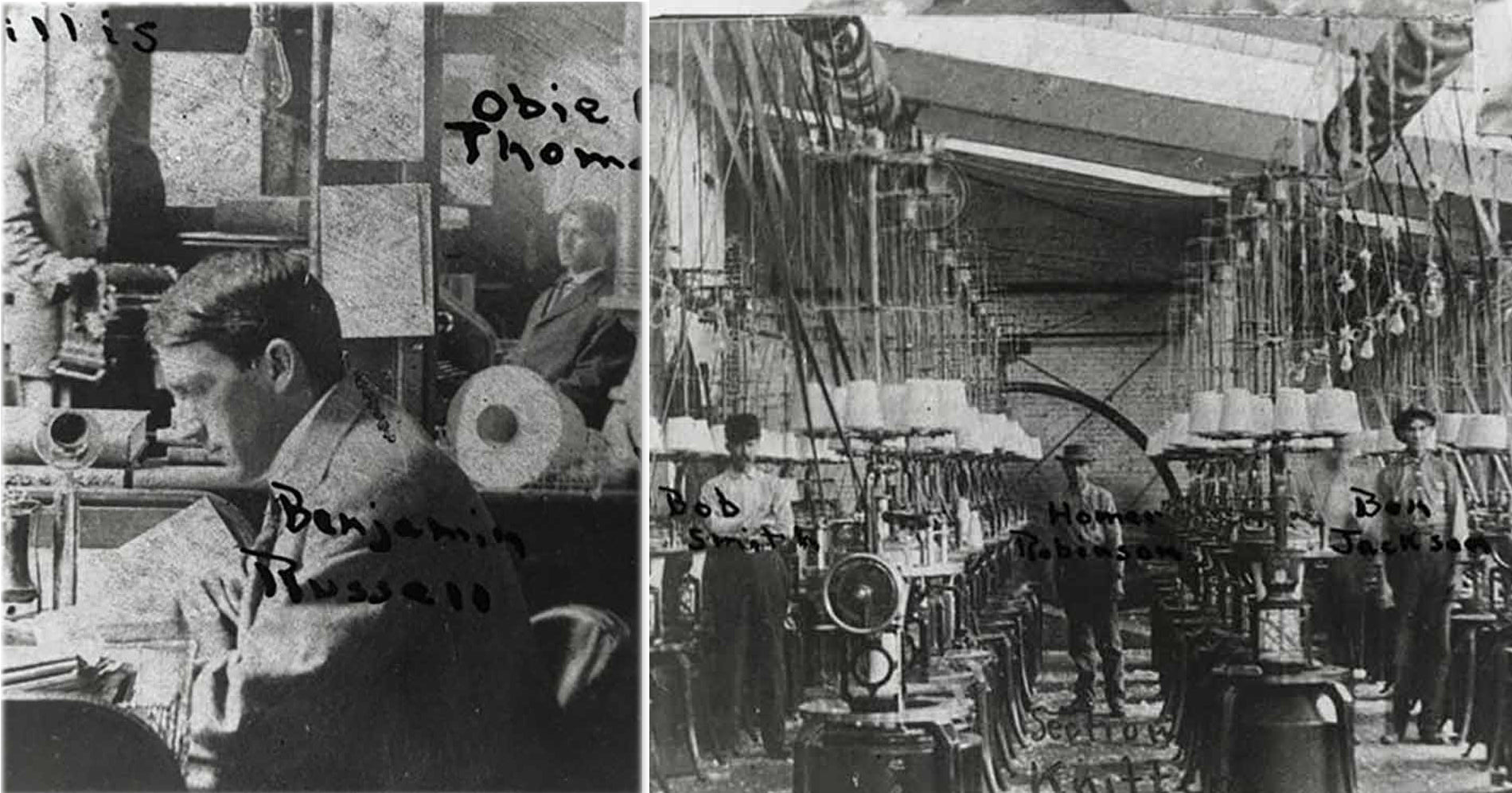In 1902, 26-year-old entrepreneur Benjamin Russelll founded Russell Manufacturing Company in Alexander City, Alabama with just 10 sewing machines and eight knitting machines. At first, the company produced women’s and children's undergarments and knit shirts — a far cry from the athletic wear for which they would later become renowned.

The modern crew-neck sweatshirt was first produced by Russell Athletic mills in 1930 - (Image by Russell Athletic)
Two decades later in 1926, Benjamin Russell Jr. — “Bennie” — a varsity quarterback at the University of Alabama, came to his father with a problem: The wool sweaters used by his team during practice were itchy and impractical, with need for frequent laundering, after which they would often shrink during the drying process. Russell Sr. repurposed the cotton top of a piece of womenswear already in production, adding a sweat-wicking, V-shaped insert and a reinforced neck. In 1930, Russell put this novel design into production, and the modern sweatshirt was born. In 1932, the firm acquired Southern Manufacturing Company, allowing it to greatly expand its budding athletic apparel business.

Russell acquired Southern Manufacturing Company in 1932 - (Image by Russell Athletic)
Champion Knitting Mills, also an American firm, added another significant innovation in 1934 when it appended a hood to its own double-thickness sweatshirt for University of Michigan football players, who needed a warm garment to wear on the bench. Adding raised lettering and insignia saw the sweatshirt’s popularity explode — the sweatshirt was well on its way to becoming a staple of American menswear.
Back at Russel, Benjamin Russel Sr. passed away in 1941, with the company reins passing to his son. Jr. successfully navigated the company through the War years, during which the Athletic division shifted largely to military production. Benjamin C. Russell passed away in 1945, after which his brother Thomas took over; by the 1960s, the Athletic division was the country’s largest manufacturer of athletic wear.

Steven McQueen wearing a cutoff sweatshirt in The Great Escape - (Image by Iconic Alternative)
At this point, the sweatshirt — both crewneck and hooded versions, which were (much) later to become known as ‘hoodies’ — were quietly infiltrating the zeitgeist. Star athletes such as Joe Louis and Mohammed Ali wore them, sure, but so did actors such as Steve McQueen, whose turn as Captain Virgil ‘The Cooler King’ Hilts in 1963’s The Great Escape saw him sporting a cutoff sweatshirt seen by millions of moviegoers around the world. In 1976, Sylvester Stallone wore (more than) one in now-famous training scenes, running up and down the steps at the Philadelphia Museum of Art in Rocky.

The infamous (and hilarious) sweatshirt John Belushi wore in Animal House - (Image by Filmgarb)
It was around this time that the hoodie began its long association with street culture — one that continues well into the 21st century. The genesis of hip-hop, which emerged among b-boys, graffiti artists, and skaters, coincided with widespread adoption of the simple garment.

Wu-Tang Clan's 1993 Enter the Wu-Tang wearing hoodies - (Image by Tidal)
By the 1980s and 1990s, Cypress Hill, the Wu-Tang Clan, and N.W.A. had all been spotted wearing hoodies — with Wu-Tang Clan’s 1993 Enter the Wu-Tang (36 Chambers) being a particularly well known example — firmly establishing its streetwear creds. (This era also coincided with the rise of the term “hoodie” into the fore.)
The utility of the hood as a mode to obscure one’s face did indeed give the hoodie associations, in certain circles, of criminality — one which would lead to stereotyping that resulted in the tragic death of Trayvon Martin in 2012, and led to the “Million Hoodie March” in NYC in 2013. Today, however, the hoodie is a firmly established fashion trope, often recontextualized in full-on luxury format by brands such as Bottega Veneta, Orlebar Brown, and Todd Snyder. (In these examples, the common cotton has been replaced by cashmere and merino wool.)
The original crewneck hoodie, developed and perfected by brands such as Russell and Champion, has also regained popularity, with Champion in particular resurfacing and being discovered by new generations of wearers via partnerships and collaborations with retailers and other companies. Thus, nearly a century after its introduction, the sweatshirt remains a popular sartorial icon, as American as apple pie — though arguably more useful.

Midweight Pocket Sweatshirt in Hickory - (Todd Snyder)
If you’re looking for a sweatshirt in the classic American athletic mold but don’t want to shell out a ton of cash, Russel still makes one — but keep in mind that the Dri-Powder Fleece Crew Sweatshirt ($20) is half-cotton, half-polyester. Slightly more high-touch is the Todd Snyder X Champion Midweight Pocket Sweatshirt ($98), which, though produced offshore, features French terry construction, a cross-grain cut to prevent shrinkage, and a hand-pressed left chest pocket. If you’d like an elevated take in a different material, try the Wallace & Barnes Boiled Merino Wool Crewneck Sweatshirt ($148) from J. Crew, which is produced from 100% merino wool and is available in several colors.

10-Year Pullover Hoodie - (Huckberry)
As far as hoodies are concerned, try the Ametora Hoodie ($54) from Rowing Blazers for a basic, good-looking option for not too much scratch — made of French terry, it’s produced in Portugal. The 10-Year Pullover Hoodie ($118) from Flint and Tinder, made from cotton and polyester, is cut, sewn, and finished in Los Angeles, and comes in a wide range of muted colors. Finally, the The Montauk Hooded Sweatshirt ($194) from Jungmaven is cut and sewn in Los Angeles from a 9.6-oz hemp-fleece blend — slightly unconventional, it’s an (subtly) elevated take on a classic garment.













